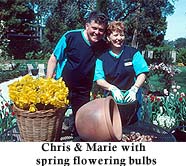 Springtime is when you reap
the rewards of your hours of hard labour in the garden as it comes to life. Bulbs that
were carefully planted in autumn start to show
off their dazzling display of colours, shapes and fragrances.
Springtime is when you reap
the rewards of your hours of hard labour in the garden as it comes to life. Bulbs that
were carefully planted in autumn start to show
off their dazzling display of colours, shapes and fragrances. Brightly coloured
tulips adorn parks and gardens everywhere, sweetly scented jonquils, freesias and
hyacinths are dotted amongst paths and rockeries and snowdrops, ranunculus and daffodils
provide splashes of colour around trees and shrubs throughout
the garden. |
|
|
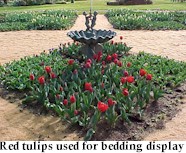 Spring flowering bulbs can be used in a number of ways; depending on the effect you want to create. Bold coloured
flowers such as tulips and daffodils make a dramatic statement when mass planted, like
those you see at Tesselaar’s tulip festival or Floriade in Canberra,
Spring flowering bulbs can be used in a number of ways; depending on the effect you want to create. Bold coloured
flowers such as tulips and daffodils make a dramatic statement when mass planted, like
those you see at Tesselaar’s tulip festival or Floriade in Canberra,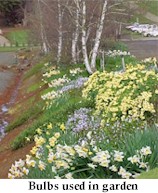 but they can be just as effective in a home garden on a smaller
scale when planted in large clumps or rows. Daffodils, jonquils, freesias and snowdropscan
be used to create an ‘English Garden’ look but they can be just as effective in a home garden on a smaller
scale when planted in large clumps or rows. Daffodils, jonquils, freesias and snowdropscan
be used to create an ‘English Garden’ look
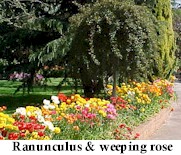 along
driveways or around trees when the clumps are left to naturalise amongst the grass.
Ranunculus and anemones are suitable for bedding displays, while smaller flowers such as
grape hyacinths make dainty borders for garden beds. Fragrant flowers such as freesias and
hyacinths can be used near paths and doorways as natural air fresheners, and tulips,
hyacinths and daffodils planted in pots can be used to brighten up patios or windowsills.
When it comes to using bulbs in the garden, the possibilities are endless. along
driveways or around trees when the clumps are left to naturalise amongst the grass.
Ranunculus and anemones are suitable for bedding displays, while smaller flowers such as
grape hyacinths make dainty borders for garden beds. Fragrant flowers such as freesias and
hyacinths can be used near paths and doorways as natural air fresheners, and tulips,
hyacinths and daffodils planted in pots can be used to brighten up patios or windowsills.
When it comes to using bulbs in the garden, the possibilities are endless. |
|
|
 Tulips are well known and loved
for their vibrant colours that make such eye-catching displays in raised beds and tubs.
They are also popular as pot plants, on windowsills and table settings. Tulips are well known and loved
for their vibrant colours that make such eye-catching displays in raised beds and tubs.
They are also popular as pot plants, on windowsills and table settings.
Growing tulips is easy and fun, and it only takes a little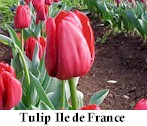 bit of
effort to produce a fabulous display each year. Tulip bulbs need to be placed in the
crisper of your fridge for 4 weeks before planting. This cold treatment is part of their
natural development process, as tulips originate from climates where the ground is frozen
for part of the year. After this, plant them in late bit of
effort to produce a fabulous display each year. Tulip bulbs need to be placed in the
crisper of your fridge for 4 weeks before planting. This cold treatment is part of their
natural development process, as tulips originate from climates where the ground is frozen
for part of the year. After this, plant them in late
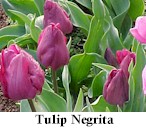 autumn in a
sunny position in a well-drained, rich soil. Water them well during the flowering season
and remove any spent flowers, letting the leaves die down naturally to replenish the
bulbs’ energy for next season. Once the leaves have died down you can lift the bulbs
and store them in a cool, dry place over the summer before they go back into the fridge
for next season. autumn in a
sunny position in a well-drained, rich soil. Water them well during the flowering season
and remove any spent flowers, letting the leaves die down naturally to replenish the
bulbs’ energy for next season. Once the leaves have died down you can lift the bulbs
and store them in a cool, dry place over the summer before they go back into the fridge
for next season.
Popular varieties of Tulips include Yokahama, which has golden
yellow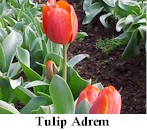 flowers on strong stems, Ile de France which has beautiful blood
red blooms, the very attractive dark purple variety Negrita and the later flowers on strong stems, Ile de France which has beautiful blood
red blooms, the very attractive dark purple variety Negrita and the later
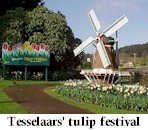 flowering pink
variety Ganders Rhapsody. One particularly striking variety is Adrem, which has soft orange blooms edged with bright yellow and makes an
excellent potted specimen. flowering pink
variety Ganders Rhapsody. One particularly striking variety is Adrem, which has soft orange blooms edged with bright yellow and makes an
excellent potted specimen.
Just a short drive from Chris & Marie's Plant Farms is
the annual tulip festival held at Tesselaars
Tulip Farm, which is on in late September to early October. This is a great place to
see how tulips, daffodils and other bulbs can be used in garden situations. |
|
|
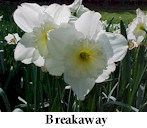 Daffodils and jonquils are among
the most popular spring flowering bulbs, with hundreds of different colours and forms
available. They are very versatile and can be used massed in displays, as filler plants
amongst garden beds and rockeries or in window boxes and tubs on patios. They like a sunny
position in well-drained soils, and if left undisturbed will multiply freely to form large
clumps. It is best to lift them every few years and divide them in late autumn to avoid
overcrowding & shy flowering. Daffodils and jonquils are among
the most popular spring flowering bulbs, with hundreds of different colours and forms
available. They are very versatile and can be used massed in displays, as filler plants
amongst garden beds and rockeries or in window boxes and tubs on patios. They like a sunny
position in well-drained soils, and if left undisturbed will multiply freely to form large
clumps. It is best to lift them every few years and divide them in late autumn to avoid
overcrowding & shy flowering. |
| Water well during flowering, and allow them to dry
out once the leaves die down completely. Fertilise with blood and bone or a specially
formulated bulb fertiliser before and after flowering. |
|
|
|
|
|
|
|
|
Melbourne’s
best value Mondo grass! 4" pots chock-a-block full of mondo grass only $2.75!!

Mondo Borders
Throw Away The Shears! |
|
|
|
|
|
|
|
 |
|
|
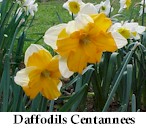 The
most well known daffodils are the large yellow trumpet varieties. This The
most well known daffodils are the large yellow trumpet varieties. This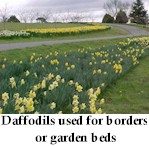 includes the old favourite King Alfred, which is a beautiful commonly
seen in older style gardens. There are pink and orange cup daffodils like Coral Blush
which has elegant straight trumpets of pink and red letter day with golden yellow petals
with an orange trumpet. Other types of Daffodils also include flat cups such as John
Willis a graceful flower with round white petals and a flat citrus lemon center edged
white and lightly ruffled & double flowering varieties such as white flowering Ice
King. Perhaps the most unusual of them all is the split corona types like Pickup which has
pure white petals and a deep orange split cup which matures to a dazzling red. includes the old favourite King Alfred, which is a beautiful commonly
seen in older style gardens. There are pink and orange cup daffodils like Coral Blush
which has elegant straight trumpets of pink and red letter day with golden yellow petals
with an orange trumpet. Other types of Daffodils also include flat cups such as John
Willis a graceful flower with round white petals and a flat citrus lemon center edged
white and lightly ruffled & double flowering varieties such as white flowering Ice
King. Perhaps the most unusual of them all is the split corona types like Pickup which has
pure white petals and a deep orange split cup which matures to a dazzling red.
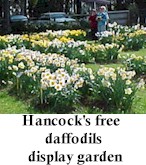 Jonquil varieties are characterised by their small
prolific flower heads and a beautiful perfume. Popular varieties
include Erlicheer, a double creamy white form and the delightful Grand Monarch which has
white petals and yellow cups. beautiful perfume. Popular varieties
include Erlicheer, a double creamy white form and the delightful Grand Monarch which has
white petals and yellow cups.
A great place to see the many unusual varieties of daffodils and jonquils that
are available is only a short drive from Chris & Marie's Plant Farms. Hancock’s daffodil farm at
Menzies Creek has a fantastic display garden, which is open to the public for free every
day throughout September, and is well worth a visit. |
|
|
|
|
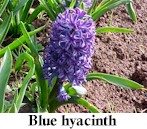 Sweet smelling
hyacynths come in a range of colours from deep reds through to pinks, purples, whites,
blues and yellows, and make ideal garden or container plants. They are best planted close
to paths or doorways, or in pots that can be brought inside to let their perfume be fully
appreciated. Hyacinths prefer to be a little on the dry side while growing, with just
enough water to stop them drying out. They like full sun but not where they are likely to
get too hot. Although hyacynths can be left to flower again in the following season, the
results each year are likely to be less reliable. The best way to treat them is replace
the Sweet smelling
hyacynths come in a range of colours from deep reds through to pinks, purples, whites,
blues and yellows, and make ideal garden or container plants. They are best planted close
to paths or doorways, or in pots that can be brought inside to let their perfume be fully
appreciated. Hyacinths prefer to be a little on the dry side while growing, with just
enough water to stop them drying out. They like full sun but not where they are likely to
get too hot. Although hyacynths can be left to flower again in the following season, the
results each year are likely to be less reliable. The best way to treat them is replace
the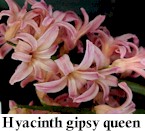 bulbs each year with fresh ones, to ensure prolific flowering
displays. The most popular varieties of hyacinths are Pink Fondant, a highly perfumed
variety and white pearl. Other more unusual colours include the yellow Gipsy Princess, the
deep wine red variety Jan Bos, and the autumn shades of Gipsy Queen. bulbs each year with fresh ones, to ensure prolific flowering
displays. The most popular varieties of hyacinths are Pink Fondant, a highly perfumed
variety and white pearl. Other more unusual colours include the yellow Gipsy Princess, the
deep wine red variety Jan Bos, and the autumn shades of Gipsy Queen.
Bluebells, on the other hand prefer moist soils in partly shaded positions and love plenty
of water during flowering. They too are useful border and rockery plants, and look right
at home in a cottage garden setting. Bluebells can be left undisturbed for a few years,
after which they should be lifted and divided to avoid overcrowding.
|
|
|
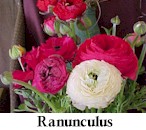 Very popular with gardeners because of their prolific displays of bright
coloured flowers.
Very popular with gardeners because of their prolific displays of bright
coloured flowers.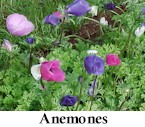 Ranunculus and anemones look fantastic when grown in mass plantings or
as borders or in window boxes and tubs. They are excellent
rockery plants and are perfect for cut flowers. They are usually treated as annuals and it
is important when you plant them to make sure that their claws face downwards. Ranunculus and anemones look fantastic when grown in mass plantings or
as borders or in window boxes and tubs. They are excellent
rockery plants and are perfect for cut flowers. They are usually treated as annuals and it
is important when you plant them to make sure that their claws face downwards.
Keep them well fed and watered during the flowering season and they will reward you with a
beautiful late winter-early spring display. |
|
|
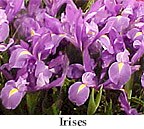 Everybody who has ever set foot inside a florist’s shop will know how
useful irises are in providing colour and style to flower arrangements. Beautiful colored
flowers appear amongst bright green strap-like leaves, and the plants make excellent
borders and potted plants. The purple and blue colours of the irises contrast wonderfully
with bright yellow flowers such as daffodils and yellow tulips, and can be used together
to create spectacular effects along paths and driveways. They are frost hardy and do best
in a sunny, Everybody who has ever set foot inside a florist’s shop will know how
useful irises are in providing colour and style to flower arrangements. Beautiful colored
flowers appear amongst bright green strap-like leaves, and the plants make excellent
borders and potted plants. The purple and blue colours of the irises contrast wonderfully
with bright yellow flowers such as daffodils and yellow tulips, and can be used together
to create spectacular effects along paths and driveways. They are frost hardy and do best
in a sunny, well-drained position. well-drained position. |
| Bulbs, bulbs and more
bulbs |
|
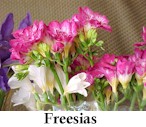 Lots of other varieties of spring flowering bulbs are
available to help make your garden a work of art. Grape hyacinths are dainty little plants
with blue hyacinth like flowers that make ideal border or rockery plants. Grow them in a
cool sunny or partly shaded position, and leave to naturalise.
Lots of other varieties of spring flowering bulbs are
available to help make your garden a work of art. Grape hyacinths are dainty little plants
with blue hyacinth like flowers that make ideal border or rockery plants. Grow them in a
cool sunny or partly shaded position, and leave to naturalise.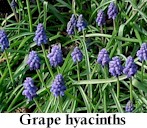 Freesias are another popular bulb with an
unmistakable perfume that can also be left to naturalise. They are available in a wide
range of colours, and are best used in areas where their scent can be appreciated, such as
near paths, windows and doorways. Snowdrops have lovely white perfumed flowers with
touches of green on the petals, and make great borders and rockery plants. They too can be
left to naturalise, and along with bluebells and daffodils can be used around deciduous
trees like birches to create a natural woodland look. |
The Annual Dutch
Bulb Market is on from February to may
at Chris & Marie's Plant Farms |
|
Home | Specials
| Products |
Contact us | Services
|
Jobs
|
Gift Voucher |
|